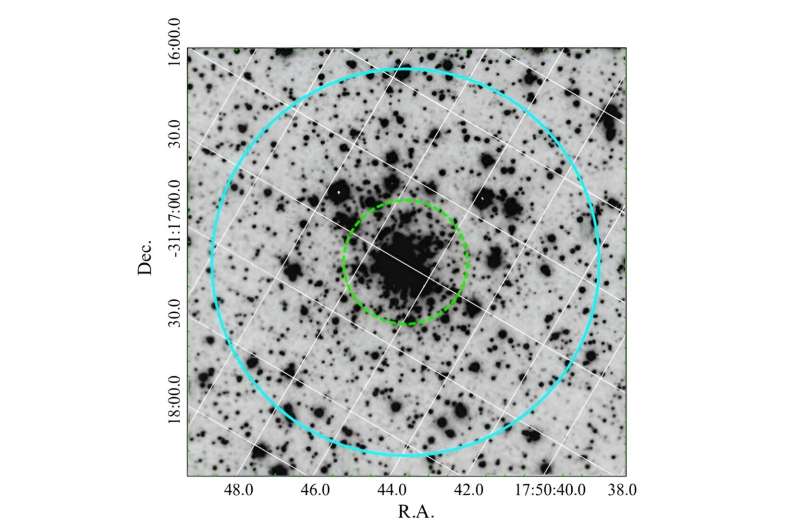Using the Green Bank Telescope (GBT), astronomers have observed a globular cluster known as Terzan 6. They detected a new millisecond pulsar that is likely associated with this cluster. The finding was reported in a research paper published September 17 on the pre-print server arXiv.
Pulsars are highly magnetized, rotating neutron stars emitting a beam of electromagnetic radiation. The most rapidly rotating pulsars, with rotation periods below 30 milliseconds, are known as millisecond pulsars (MSPs). Astronomers assume that they are formed in binary systems when the initially more massive component turns into a neutron star that is then spun up due to accretion of matter from the secondary star.
Terzan 6 is a metal-rich core-collapsed Galactic globular cluster at a distance of about 21,800 light years away. Although the cluster is known for decades, so far no pulsars have been detected in it. However, its high stellar encounter rate suggests that it may harbor dozens of such objects.
Now, a team of astronomers led by Shi-Jie Gao of the Nanjing University in China reports the detection of a new MSP, that may be the first known pulsar in Terzan 6. The discovery is a result of a targeted search of this cluster with the GBT at C-band (4–8 GHz).
“Here we report the discovery of a 5.33 ms pulsar associated with Terzan 6, referred to as PSR J1751–3116A,” the researchers wrote.
As noted in the paper, PSR J1751–3116A has a spin period of approximately 5.33 milliseconds, while its dispersion measure is about 383.08 pc/cm-3. The obtained dispersion measure strongly supports the association between PSR J1751–3116A and Terzan 6.
The study found that the flux density of PSR J1751–3116A at 6.0 GHz is at a level of 3.0 µJy. Assuming a spectral index of −1.4, the astronomers estimated that the pulsar’s flux density at 1.44 GHz is approximately 23 µJy.
The authors of the paper suppose that PSR J1751–3116A is an isolated millisecond pulsar, which is consistent with the Terzan 6’s classification as a core-collapsed cluster. They note that PSR J1751–3116A potentially formed through dynamical interactions.
Summing up the results, the researchers note that they hope for further pulsar discoveries in Terzan 6 with the use of existing radio telescopes at higher frequencies.
“In consideration of the exceptionally high stellar encounter rate, more sensitive searches such as using GBT and MeerKAT (e.g., TRAPUM, a MeerKAT large survey project) are expected to result in further pulsar discoveries in Terzan 6,” the scientists conclude.
More information:
Shi-Jie Gao et al, Discovery of a millisecond pulsar associated with Terzan 6, arXiv (2024). DOI: 10.48550/arxiv.2409.10801
Journal information:
arXiv
© 2024 Science X Network
Citation:
New millisecond pulsar discovered (2024, September 23)
retrieved 24 September 2024
from https://phys.org/news/2024-09-millisecond-pulsar.html
This document is subject to copyright. Apart from any fair dealing for the purpose of private study or research, no
part may be reproduced without the written permission. The content is provided for information purposes only.

